Sold Ceramics
Sold Japanese wares with Western Designs 1653-1800
Page 1
The knowledge and expertise required to make porcelain was already present in Japan as far back as the early 17th century. According to legend a Korean potter discovered clay suitable for making porcelain near Arita on the island of Kyushu in the south of Japan in around 1605. Porcelain made from this clay, called shoki-Imari, was intended for the foreign market and soon acquired a surprisingly characteristic Japanese style of decoration, first with a blue underglaze decoration and later in enamel colours. The experience of the manufacturers with enamel colours turned out to be of great importance later. (source: Groninger Museum, Groningen)
When Japanese potters started to make porcelain. It was inspired by underglaze blue porcelain manufactured in kilns of Southern China. By the mid-17th century, Chinese porcelain went into decline due to social unrest and accompanying dynastic change. Dutch merchants, from their base on the small island of Deshima, near Nagasaki, were permitted to trade with Japan. Responding to European demand, the Dutch encouraged the fledgling Japanese porcelain industry to fill the gap left by China.
The porcelain the Dutch brought to Europe in the 17th century was in most cases consciously designed to cater to western tastes. To ensure that they would find a ready market, the Dutch often made wooden or earthenware models of designs and sent those to Japan to be copied.
Flasks, ewers and large dishes are examples for shapes made for the Dutch. They are painted in underglaze blue or a palette of enamels dominated by red, green and blue with flowers, figures and landscapes which would not follow traditional Japanese aesthetics. Vessels with landscape designs are often inspired by 17th century Chinese Transitional style. Plates decorated with designs organized by panels imitate the successful blue-and-white Chinese Kraak ware. To make these export wares even more attractive for the Dutch clients numbers of early Japanese export wares are painted with a stylized tulip, referring to the tulipomania, the great Dutch craze of the 1630s. (source: Keramiek Museum Princessehof, Leeuwarden)
Japon de commande
In Japan porcelain was also manufactured to order, both for private parties as well as, in a few cases, for the Dutch East India Company, (Vereenigde Oost-Indische Compagnie, VOC). The private buyers were in fact solely Dutch East India Company employees of Deshima, The Dutch trading post in Nagasaki in Souhern Japan. As only European company, The Dutch East India Company was given the monopoly to trade in Japan. Japon de commande was therefore much more exclusive than Chine de commande.
Striking are the blue dishes featuring the Dutch East India Company monogram on them. There is hardly any record of these specific pieces to be found in the Dutch East India Company achieves, but they were apparently often manufactured to order as the Company's 'official' tableware, which was used aboard the ships, in the trading posts all over Asia and even at the dinner table of the Governor-General of the Dutch East Indies in Batavia. Oddly enough it was never actually made in China itself, nor painted in enamel colours. Other motifs are family coats of arms, depictions of Dutch landscapes as well as of Dutch people and their ships. Also, quite striking are the bulbous flasks initialled with either their alcoholic or medicinal contents or with their owner's name. (Source: Groninger Museum)

Sold Ceramics - Sold Japanese wares with Western Designs 1653-1800 - Page 1
Object 2011969
Dish
Japan
1660-1670
Height 28 mm (1.10 inch), diameter of rim 220 mm (8.66 inch), diameter of base 140 mm (5.51 inch), weight 449 grams (15.84 ounce (oz.))
Dish on a flat base with a broad firing-ring and five spur-marks in a X-pattern. Broad flat rim. Decorated in underglaze blue with three reclining figures in a simplified landscape with rocks, clouds and vegetation. The rim with four medallions filled with either a standing or a reclining figure on a blue ground with a petal or a circle pattern in blue. The reverse is undecorated. (Jörg 2003/1, p.237, cat. 301)
This dish was copied from a Dutch delftware dish. The Delft dish was decorated in the style of Chinese Transitional ware. The figures on this Delft model were probably misinterpreted by the Japanese painter who gave them a sheep-like head. (Jörg 2003/1, p.237, cat. 301)
Dish, Dutch Delftware, 1660s, Groninger Museum, Groningen, inv. nr. 1967-132) (not included in this sale/offer) (Reproduced from: Fine & Curious: Japanese Export Porcelain in Dutch Collections, (C.J.A. Jörg, Hotei Publishing, Amsterdam 2003), p.237, cat. 301a)
For an identically decorated dish, please see:
- Fine & Curious: Japanese Export Porcelain in Dutch Collections, (C.J.A. Jörg, Hotei Publishing, Amsterdam 2003), p.237, cat. 301.
For the original Dutch Delftware dish, c.1660, please see:
- Fine & Curious: Japanese Export Porcelain in Dutch Collections, (C.J.A. Jörg, Hotei Publishing, Amsterdam 2003), p.237, cat. 301a.
Condition: Restored, both sides sprayed over with a transparent lacquer.
Reference:
Price: Sold.

Sold Ceramics - Sold Japanese wares with Western Designs 1653-1800 - Page 1
Object 2012436
Apothecary bottle
Japan
1670-1700
Height 258 mm (10.16 inch), diameter belly 175 mm (6.89 inch), diameter of mouthrim 37 mm (1.46 inch), diameter of footring 86 mm (3.39 inch), weight 1,210 grams (42.68 ounce (oz.))
Globular bottle on footring, tapering neck, the mouth with a double flange. Decorated in underglaze blue with fruiting pomegranate branches, peonies and birds surrounding a circle containing the initials 'H:S;'. On the shoulder a blue band, on the neck flowering plants and grasses.
Apothecary bottles were produced for the Dutch in Arita between 1652 and 1727.
For an earlier sold example please see:
Bottles with initials can be dated accordingly as part of this group.
Known initials are: IC, IVH, PVD, PW, IS-M, PD, LVR, VOC, Ds. Vandr. Hof, RW, FW, CB, CK, VCL, LG, AL, HS, DSM, DDH, IS-HB, GDH, WV, POK, B, NA, M, LP, OJK, WTR, BS. wn. and ICT. In some cases it is certain (or almost certain) that the initials refer to an owner or commissioner for example:
IC: these initials are assumed to be those of Johannes Camphuis, director of the VOC office in Decima in 1672, 1674 and 1676 and Governor-General from 1684 until 1691.
WV: could stand for Willem Volger who was in Decima in 1664 and 1666
GDH: could stand for Gerrit de Heere (1694)
BS.wn.: could stand for Balthasar Sweers Willemsz. (1690)
WTR: probably means Willem ten Rhijne, a famous surgeon who was in Decima from 1674 to 1676.
IVH: these initials are said to have belonged to Joan van Hoorn, Governor-General from 1704 untill 1709.
The other known initials cannot easily be connected with specific names. They might stand for other VOC employees at Decima, but unfortunately a list of all merchants, assistants, bookkeepers, surgeons and lower personnel working there has not yet been compiled. Besides those men, other people outside Decima may have ordered bottles with their initials through friends or relatives in Japan. For instance the Reverend Van der Hof apparently never was in Decima but the famous bottle with his name (Ds. Vandr. Hof) fully written, the only example known, undoubtedly was made especially for him. The connection of initials with directors, a Governor-General and a surgeon, although not proven firmly, indicate a fashion in the upper levels of the Dutch society in Decima and Batavia. This small group could afford luxury objects, they followed each other in acquiring novelties and this therefore is the natural environment to investigate when searching for identification of other initials.
Following this line of thought, it is tempting to assume that the 'H:S' initials might refer to Henricus (Hendrick) Swaardecroon (1667-1728), Governor-General of the Dutch East Indies who already worked for the VOC in the East from 1684 onwards in various influential positions and finally was appointed Governor-General in 1718 (1718-1725). It would therefore have been easy for him to order these Japanese flasks with his initials through his contacts at that time. Although his last name is originally Zwaardecroon with a 'Z', the spelling at that time was also Swaardecroon with a 'S', as can be seen on this portrait made by an yet unknown artist (this portrait is not included in this offer/sale).
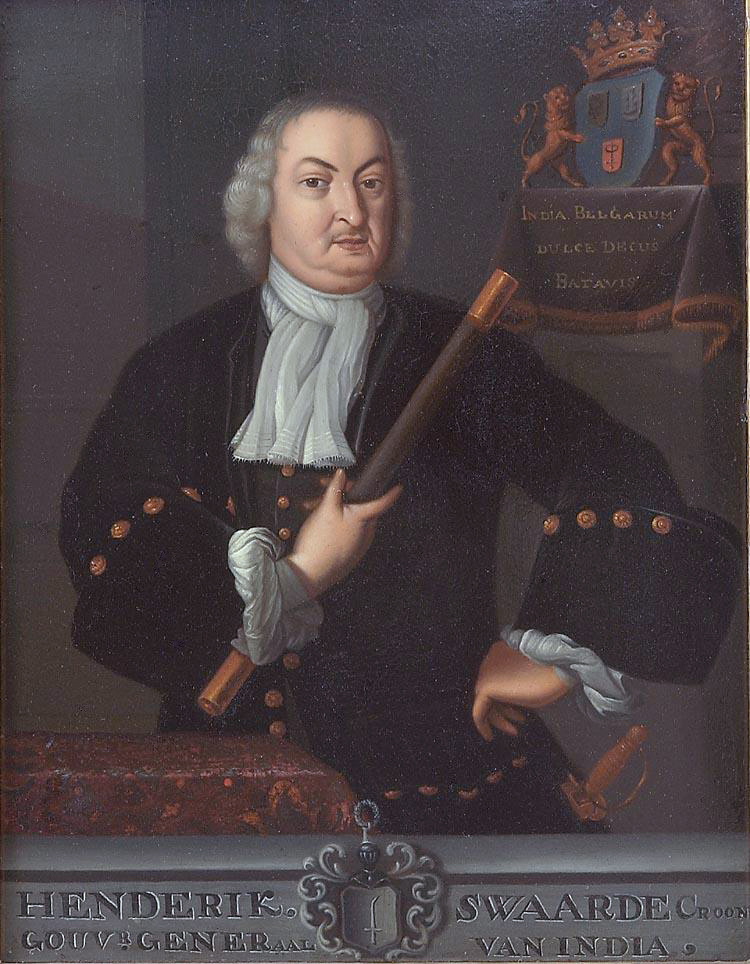
More problems arise for the one capital initials. Two are known thus far: an 'M' and a 'B'. Do they stand just for a family name, or is something else indicated, not a name but some kind of liquor? 'M' for instance, could mean 'Madeira', a strong, sweet wine much favored by the Dutch and the 'B' could be 'Brandewijn' (brandy). The bottles with the 'IS-M' and the 'IS-HB' initials probably have a double meaning: 'IS' stands for the name of the owner, who had made a set for Madeira wine (M) and one for 'Hollandsche Brandewijn' (HB, Dutch brandy). The initials 'FW' might have referred to the contents of 'Franse wijn' (French wine) as can be seen on a Japanese Imari tea bowl and saucer decorated with a river landscape with two fishermen in a boat and two farmers with an ox. In the foreground, on a rocky promontory, shadowed by a flowering tree, we see two seated scholars. Next to them, on the ground, are placed a tall cup, a saucer dish, a food box with hashi and a clearly recognizable apothecary bottle decorated with the initials FW. It is clearly demonstrated in this decoration: apothecary bottles were used as wine bottles by the Japanese and most likely by Europeans as well.
Earlier sold object 2012088.
Earlier sold object 2012088 (close-up).
So besides referring to private individuals the initials might also indicate the contents, especially the one-letter initials and probably, too, the combination of capitals written through each other. It is very unlikely that initialled bottles were used as containers for medical or pharmaceutical fluids. Obviously they held wine or alcoholic spirits. More research has to be done to establish firm dates, a stylistic chronology and an insight in the use of these bottles by the Japanese themselves. (Jörg 1991, pp.1-26)
For an identically shaped, sized and decorated apothecary bottle, please see;
Condition: Fine crazing to the glaze and a firing tension hairline to the body.
References:
Price: Sold.

Sold Ceramics - Sold Japanese wares with Western Designs 1653-1800 - Page 1
Object 2011899
Dish
Japan
1668-1690
Height 35 mm (1.38 inch), diameter of rim 218 mm (8.58 inch), diameter of footring 113 mm (4.45 inch), weight 416 grams (14.67 ounce (oz.))
Dish on footring with a flat rim. On the base four spur-marks in a Y-pattern. Decorated in underglaze blue. In the central field the monogram of the Dutch East India Company (Vereenigde Oost-Indische Compagnie, VOC) surrounded by a peach and peony spray. The sides and rim with a continuous decoration of pierced rockwork with bamboo, flowering peony and prunus plants. The reverse is undecorated.
Dishes with the monogram of the Vereenigde Oost-Indische Compagnie (VOC), (1602-1789/1799) were probably ordered by the High Government from 1668, when it started to require porcelain for Batavia. VOC dishes were used as an early form of in-house corporate promotion at the tables of high-ranking Company employees, at the Factories in Asia, and probably in the officers' cabins aboard ship. According to Impey, Viallé has demonstrated that pieces with the VOC mark, both in the well and on the reverse, were for the exclusive use of Officers of the Company
Sherds bearing the VOC monogram have been found at three kiln sites in Arita (Tanigama. Sarugawa and Hiekoba), but apparently other kilns made them as well. The remains of many such dishes, including types hitherto unknown, have been excavated at Deshima, illustrating their use there. Interestingly, VOC dishes have not been found in the Oosterland wreck (1684-1697) or in the salvaged cargoes of other Company ships. Most VOC monogram dishes have a border design in the style of Chinese dishes from the Wanli period with six large panels, three of bamboo and blossom alternating with three of grass and peony. Between each large panel a small panel filled with a floret and scrollwork over a wash of lighter blue. Interestingly, the well-known armorial plates and dishes with the arms of the Dutch Aletta Pancras and Francois de Vicq, who married in 1667, have a very similar border design. (Ayers, Impey & Mallet 1990, p.94, Arita 2000, pp. 37-39, cats. 43-52, Impey 2002, p.55, cat. 35, Jörg 2003/1, p. 225 cat. 285), (Jörg 2003/1, p. 230, cat. 291)
On this specific VOC dish, the same continuous decoration of bamboo, flowering peony and prunus is present, however without being separated into panels. This border design seems to be unique and unrecorded in literature so far.
For objects decorated with the VOC monogram, please see;
- Porcelain and the Dutch East India Company, as recorded in the Dagh-registers of Batavia castle, those of Hirado and Deshima and other contemporary papers 1602-1682, (T. Volker, Rijksmuseum voor Volkenkunde, E.J. Brill, Leiden 1954, reprint 1971), Pl. XV, cat. 27.
- Handboek geschreven naar aanleiding van de verzamelingen in het Gemeentelijk Museum Het Princessehof te Leeuwarden / Hand book written following the collections in the Municipal Museum Het Princessehof in Leeuwarden, (N. Ottema, N.V. Uitgeversmaatschappij De Tijdstroom, Lochem, 1970), cat. 82.
- Japans porselein met blauwe decoraties uit de tweede helft van de zeventiende en de eerste helft van de achttiende eeuw. (D.F. Lunsingh Scheurleer in Mededelingenblad Nederlandse Vereniging van Vrienden van de Ceramiek, vols. 64/65, 1971), p.70, cat. 55.
- Oriental Ceramics at the Cape of Good Hope 1652-1795. An account of the porcelain trade of the Dutch East India Company with particular reference to ceramics with the V.O.C. monogram, the Cape Market and South African Collections, (C.S. Woodward, Cape Town & Rotterdam, 1974), pp.52-109.
- Blue & White. Early Japanese export ware (M. Lerner, Metropolitan Museum of Art, New York, 1978), cat. 59 & 60.
- Japanese Porcelain (S. Jenyns, Faber & Faber, London/Boston 1979), cat. 14B
- Japanese porcelain. A collector's guide to general aspects and decorative motifs (P.L.W. Arts, Lochem 1983), p. 133 cat. 79.
- Interaction in Ceramics. Oriental porcelain and Delftware. (C.J.A. Jörg, Hong Kong, 1984), pp.108-109, cat. 63.
- The Inter-Influence of Ceramic Art in East and West (Idemitsu Museum of Arts, Tokyo 1984), p. 10, cat.3.
- The Hatcher Porcelain Cargoes. The Complete Record, (C. Sheaf & R. Kilburn, Oxford 1988), p.83, Pl.123.
- Porcelain for Palaces. The Fashion for Japan in Europe 1650-1750, (J. Ayers, O. Impey & J.V.G. Mallet, Oriental Ceramic Society & The British Museum, London 1990), p.94, cat. 32 & 33, p.105, cat 53.
- The Voyage of Old-Imari Porcelains, (Kyushu Ceramic Museum, Arita 2000), cats. 43-52, 290
- Japanese Export Porcelain. Catalogue of the Collection of the Ashmolean Museum, Oxford, (O. Impey, Hotei Publishing, Amsterdam, 2002), p.51, cat. 27, p.55, cat. 35 & p.108, cat. 127.
- Fine & Curious. Japanese Export Porcelain in Dutch Collections, (C.J.A. Jörg, Hotei Publishing, Amsterdam, 2003), pp.225-229, cats. 286 - 290
- Faszination des Fremden: China - Japan - Europa, (D. Antonin & D. Suebsman, Hetjens-Museum, Deutsches Keramikmuseum Düsseldorf, 2009), pp.224-225, cat. 91.
Condition: A circular firing crack.
References:
Volker 1954, reprint 1971, Pl. XV, cat. 27
Lunsingh Scheurleer 1971, cat. 55
Ayers, Impey & Mallet 1990, cat. 32, 33 & 53
Impey 2002, cat. 27 & 35 & 127
Jörg 2003/1, pp.225-229, cats. 286-290
Antonin & Suebsman 2009, cat. 91
Price: Sold.
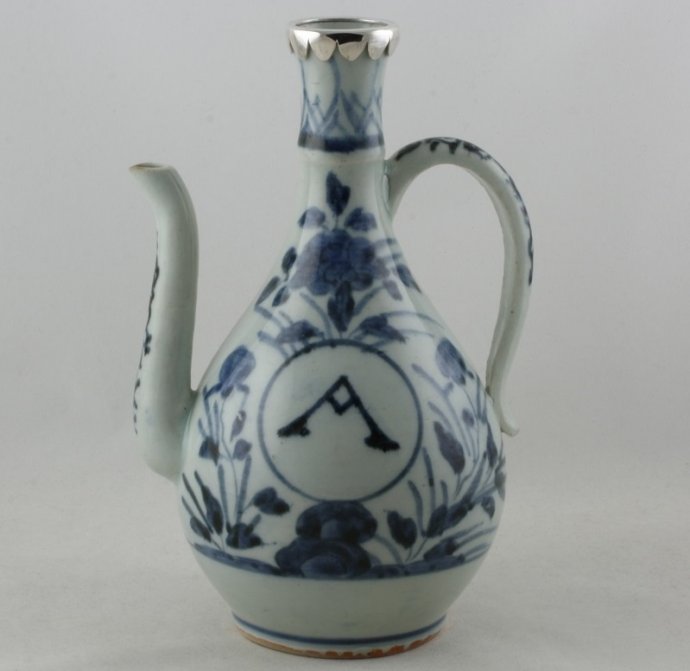
Sold Ceramics - Sold Japanese wares with Western Designs 1653-1800 - Page 1
Object 2012247
Ewer
Japan
1670-1690
Height 184 mm (7.24 inch), diameter handle to spout 115 mm (4.53 inch), diameter of mouthrim 27 mm (1.06 inch), diameter of footring 57 mm (2.24 inch), weight 395 grams (13.93 ounce (oz.))
Pear shaped ewer on footring. Slender upright spout with a curved C-shaped handle.Fitted with an contemporary unmarked Dutch silver mount. Decorated in underglaze blue with on both sides of the body a roundel inscribed with the initial 'A' (for the Dutch word azijn (vinegar)) surrounded by various grasses and plants growing from rockwork. Round the neck a pointed upturned half-leaf border and on the handle and spout classic foliate patterns.
A specific group of ewers is decorated with the letters 'O´, 'A', or 'S' indicating their contents: 'O' stands for olie (oil), 'A' for azijn (vinegar), 'L' for limoen (lemon), the 'S' or 'Z' for soya or zoja (soy). They were used at the dinner table in The Netherlands. Arts adds the letter 'C' for conserven (?) (preserves). Oil and vinegar sets with inscribed initials were made in Delft faience, often with a container for two or four ewers, such Delftware examples were used as models for the Japanese imitations. Chinese ewers of this period with initials are not known, but close copies of the Japanese pieces were made in the 18th century. 'oil and vinegar jugs' were mentioned as early as 1664, but these were probably ordinary small ewers without initials. (Arts 1983, p.50), (Jörg 2003/1, pp.176-177)
For a similarly shaped and in underglaze blue decorated ewer initialled with the letter 'A', please see:
- Fine & Curious: Japanese Export Porcelain in Dutch Collections, (C.J.A. Jörg, Hotei Publishing, Amsterdam 2003), p.176, cat. 214.
For identically shaped and sized ewers, please see:
For a sold ewer initialed with the letter 'O' for olie (oil), please see:
Condition: Firing flaws, caused by the firing process, to the handle and the underside of the spout. A partial rough unglazed upper rim of the spout and a shallow chip to the underside of the tip of the spout.
References:
Lunsingh Scheurleer 1971, cat. 108
Jörg 2003/1, cat. 214 & pp.176-177
Price: Sold.

Sold Ceramics - Sold Japanese wares with Western Designs 1653-1800 - Page 1
Object 2011431
Ewer
Japan
c.1700
Height with cover 115 mm (4.53 inch), height without cover 98 mm (3.86 inch), diameter handle to spout 115 mm (4.53 inch), diameter of mouthrim 40 mm (1.57 inch), diameter of footring 45 mm (1.77 inch), weight with cover 227 grams (8.01 ounce (oz.)), weight cover 19 grams (0.67 ounce (oz.))
Pear shaped ewer on footring. Slender upright spout with a curved C-shaped handle. Luted splayed foot with a convex double 'skin' base with a hole pierced in the outer layer. Almost flat cover with small loop ring, (intended for a silver chain, to be added by the buyer, which prevented the cover falling off). Decorated in underglaze blue with phoenix in flight and flower sprays on both sides of the body, on one side a reserved roundel with the initial 'O' for the Dutch word olie (oil), On the cover floral sprays and on the handle and spout cloud and floral motifs. Round the foot a double line.
In all probability this ewer, and similar examples, were formerly part of a set of jugs, ewers, and/or standing salts standing in fitted recesses upon a round tray with a central upright handle. These exist in several sizes, including dolls' house size, and in blue and white or in coloured Imari. The number and variety of ewers, etc. vary from four to six. Such sets were frequently split up and parts used for other purposes; a splendid example is in the Hoftafel-und Silber Kabinett, Vienna. (Lunsingh Scheurleer 1971, pp.110-111, cat. 179), (Ayers, Impey & Mallet 1990, p.226, cat. 241 & pp.229-230, cat. 246 & 247), (Impey 2002, p.107, cat. 123)
A specific group of ewers is decorated with the letters 'O´, 'A', or 'S' indicating their contents: 'O' stands for olie (oil), 'A' for azijn (vinegar), 'L' for limoen (lemon), the 'S' or 'Z' for soya or zoja (soy). They were used at the dinner table in The Netherlands. Arts adds the letter 'C' for conserven (?) (preserves. (Arts 1983, p.50), (Jörg 2003/1, p.176)
For an identically shaped and sized ewer, decorated with the initial 'O', (part of a set on its original round tray), please see:
For an identically shaped and sized ewer, decorated with the initial 'S', please see:
- Eastern Ceramics and other works of art from the collection of Gerald Reitlinger, (Ashmolean Museum, Oxford 1981), p.94, cat 265.
- Japanese Export Porcelain. Catalogue of the Collection of the Ashmolean Museum, Oxford, (O. Impey, Hotei Publishing, Amsterdam, 2002), p.107, cat. 123.
Condition: A firing tension glaze hairline to the base, a fleabite to footring and the rim of the cover and a restored end of the spout.
References:
Lunsingh Scheurleer 1971, cat. 179
Ayers, Impey & Mallet 1990, cat. 241, 246 & 247
Price: Sold.
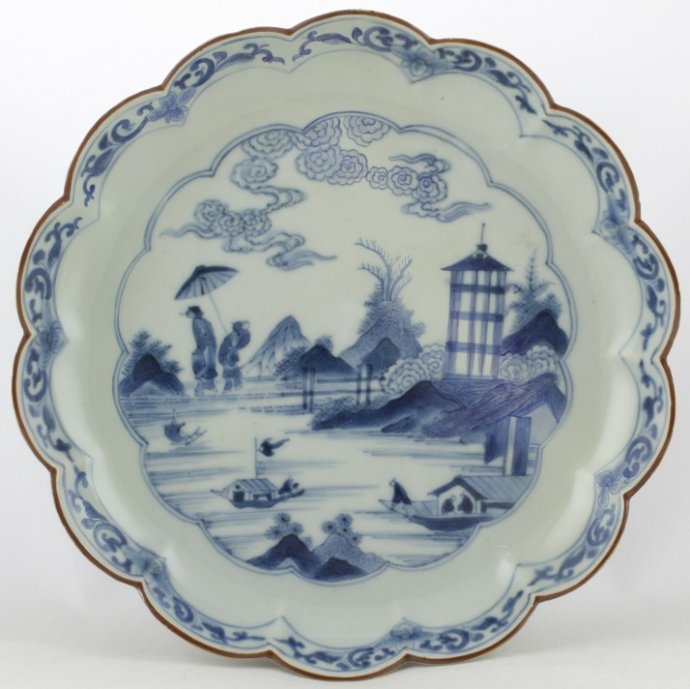
Sold Ceramics - Sold Japanese wares with Western Designs 1653-1800 - Page 1
Object 2011806
Dish
Japan
c.1700
Height 35 mm (1.38 inch), diameter of rim 204 mm (8.03 inch), diameter of footring 128 mm (5.04 inch), weight 357 grams (12.59 ounce (oz.))
Dish on footring, lobed sides with an underglaze brown-edged rim. On the base four spur-marks in a Y-pattern. Decorated in underglaze blue with a river scene with boats, a gentleman in profile is wearing a cap, his beard sticking out, his paunch protruding, looks towards the edge of the picture, a slightly smaller servant holds a large parasol above his master's head on the bank. A tower or pagoda with several storeys rises above the shoreland. Spiral clouds in the sky and round the tower. A flower and leaf border round the rim. On the reverse a scroll with pendent karakusa. On the base a square fuku (good luck) mark in seal script. (Jörg 2003/1, p.150, cat. 168)
This dish is to be seen in the context of a group of Japanese porcelains whose decorative elements were influenced by European models, for example etchings by the Dutch painter Frederic van Frytom (around 1632-1702). The Dresden dish does not display a European scene, but East Asian and Western landscape elements and figures presented in an unusual combination. The representation of the clouds and the surface of the water, however, seem s to have been modelled on European etchings. The decorations of Japanese Chinoiseries may have been a combination of different decorative elements since clouds or the motif of a gentleman and his servant under a parasol appear on numerous porcelains (Ströber 2001, p.158)
The pagoda like the parasol may have been appealing to Western buyers interested in Orientalia. The motif of the man and his parasol-bearing servant is known on related Kakiemon-style pieces. The shift in perspective from the river scene to the relatively enormous men on the bank is quite remarkable. (Jörg 2003/1, p.150, cat. 168)
Twickel Castle, Delden, The Netherlands has a large set of these dishes in three different sizes, 190 mm (7.48 inch), 205 mm (8.07 inch) and 225 mm (8.86 inch). (Jörg 2003/1, p.150, cat. 168)
For identically decorated dishes, please see:
- La maladie de porcelaine..., East Asian Porcelain from the Collection of August the Strong, (E. Ströber, Edition Leipzig, Berlin, 2001), pp.158-159, cat. 70.
- Fine & Curious: Japanese Export Porcelain in Dutch Collections, (C.J.A. Jörg, Hotei Publishing, Amsterdam 2003), p.150, cat. 168.
For slightly larger dishes that also show the motif of a group of Chinese watching 'miniature fishermen', please see:
- Porcelain for Palaces. The Fashion for Japan in Europe 1650-1750, (J. Ayers, O. Impey & J.V.G. Mallet, Oriental Ceramic Society & The British Museum, London 1990), p.158, cat. 134.
- Porzellan aus China und Japan. Die Porzellangalerie der Landgrafen von Hessen-Kassel, (Staatliche Kunstsammlungen Kassel, Berlin 1990), pp.466-467, cat. 244 a/b.
- Japanese Export Porcelain. Catalogue of the Collection of the Ashmolean Museum, Oxford, (O. Impey, Hotei Publishing, Amsterdam, 2002), p.116, cat. 143.
Condition: Restored.
References:
Ayers, Impey & Mallet 1990, cat. 134
Ströber 2001, pp.9-11 & cat.70
Price: Sold.
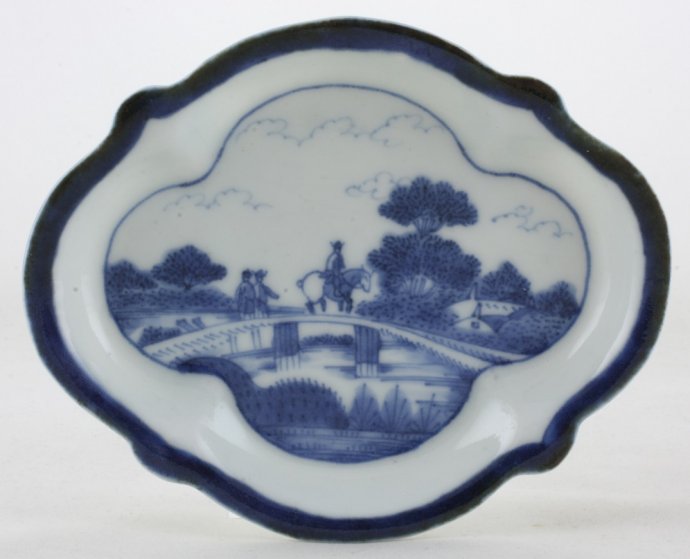
Sold Ceramics - Sold Japanese wares with Western Designs 1653-1800 - Page 1
Object 2012316
Saucer
Japan
c.1700
Height 22 mm (0.87 inch), diameter of rim 128 mm (5.04 inch) x 103 mm (4.06 inch), diameter of footring 80 mm (3.15 inch) x 62 mm (2.44 inch), weight 76 grams (2.68 ounce (oz.))
Saucer or pattipan of lobed oval shape on a four-lobed footring. Decorated in underglaze blue with a European landscape with trees, a house and a bridge with two men and a horseman. Round the rim a dark blue border. The reverse in undecorated. Marked on the base with a six-character Chenghua mark.
Frederik van Frijtom (c.1632-1702)
Frederik van Frijtom (c.1632-1702) was a delft faience painter who specialised in plates, dishes and plaques with landscapes in blue. The elements that characterise his work include the wide blank rims of his plates and dishes, the detailed painting of trees and landscapes, and a specific way of drawing clouds, outlining them with small bows. His work shows idyllic, pastoral scenes with people riding horses, fishing from a boat, walking or hunting. Other Delft factories made pieces with similar scenes (and related scenes feature in the work of Dutch engravers and artists of that period), but Van Frijtom produced pieces of outstanding quality. He seemed to have made single items only, because no two pieces of the same design are known. (Jörg 2003/1, p.211)
It is unknown when and where Van Frijtom was born. He married Lijntge Stevens, a spinster from Pernis, in Delft in 1652. They lived in 'In den gulden Brack' in the Molslaan in Delft, and had several children. He was doing well and bought real estate in Delft several times. After his wife died he married again with Elisabeth Verschouw, under a prenuptial agreement. His works are known from 1652 to 1702. He made paintings, often landscapes, mostly on panel and sometimes on canvas. However, he specialized for the Delft pottery industry in plate decorations and tile paintings. He found original decorative possibilities without using the usual symbols. A will in 1701 showed that he was ill. After his death in 1702, twelve porters carried him to his grave in the Nieuwe Kerk in Delft. (Wikipedia)
Reproduced from: Frederik van Frytom 1632-1702. Life and work of a Delft pottery-decorator. (A. Vecht, Scheltema & Holkema N.V., Amsterdam, 1968), p.26. This autogragph is not included in this sale/offer. (copyright in bibliographic data and images is held by the publisher or by their respective licensors: all rights reserved)
The Frederik van Frijtom (c.1632-1702) style.
The Groninger Museum has two interesting, very rare early plates, each with a design clearly taken from a Delftware example, and it is tempting to connect them to the models brought over from The Netherlands in 1662. The Japanese copied not only the decoration from the Delft pieces, but also the flat base without a footring. They may represent a short-lived fashion, as it is difficult to find other examples of Dutch style decorations in the second half of the 17th century, apart from the pieces mentioned above.
Then, unexpectedly, there was a varied output of pieces painted with Dutch landscapes, ships and harbour scenes in underglaze blue - no polychrome examples are known. Shapes include teapots. teacups and saucers, pattipans (saucers for teapots and milk jugs), plates and bowls. This type of decoration has been labelled the 'Frijtom' style.
This saucer or pattipan (a stand for a teapot or milk jug, or used as spoon tray) belongs to another category within the 'Frijtom' Group. The shape and decoration imitate a Delftware model in the Prinsenhof Museum, Delf, painted in the Frijtom style and dated to 1684, as part of a set of five different saucers. The motif of the horseman, the main element of the design, is also seen on other export ware. Two teacups with this design are in the Amsterdam Rijksmuseum (Arita 2000, cat.70); two others from the Gerry Collection are in the Metropolitan Museum of Art, New York (Ford 1989).
In his Fine & Curious on page 244, cat. 314a Jörg shows an example of an Dutch Delftware saucer, on the flat surface, within a blue line, a water landscape with a wooden bridge on which there is a horseman followed by two other men. To the right in the distance tall trees and a farmhouse. Blue border. Marked on the base: MB 1684, Prinsenhof Museum, Delft TDA126c. Reproduced from: Fine & Curious. Japanese Export Porcelain in Dutch Collections, (C.J.A. Jörg, Hotei Publishing, Amsterdam, 2003), p.244, cat. 314a. This saucer is not included in this sale/offer. (copyright in bibliographic data and images is held by the publisher or by their respective licensors: all rights reserved)
It is a curiosity that these Japanese dishes / saucers were in turn copied in England at the Bow factory from c.1752 and there is even a Chinese version in the Ashmolean Collection. (Ayers, Impey & Mallet 1990, p.114, Impey 2002, p.228 )
For an identically shaped and decorated saucers, please see:
- The Wrestling Boys. Chinese and Japanese Ceramics from the 16th to the 18th Century in the Collection at Burghley House, (The Trustees of Burghley House, Stamford 1981), p.12, cat. 36.
- The Voyage of Old-Imari Porcelains, (Kyushu Ceramic Museum, Arita 2000), p.47, cat. 39.
- Fine & Curious: Japanese Export Porcelain in Dutch Collections, (C.J.A. Jörg, Hotei publishing, Amsterdam, 2003), p.244, cat. 314.
For an originally shaped and decorated Delftware saucer, please see:
- Frederik van Frytom 1632-1702. Life and work of a Delft pottery-decorator. (A. Vecht, Scheltema & Holkema N.V., Amsterdam, 1968), p.77, cat.43.
- The Wrestling Boys. Chinese and Japanese Ceramics from the 16th to the 18th Century in the Collection at Burghley House, (The Trustees of Burghley House, Stamford 1981), p.13, cat. 38.
- Fine & Curious: Japanese Export Porcelain in Dutch Collections, (C.J.A. Jörg, Hotei publishing, Amsterdam, 2003), p.244, cat. 314a.
Condition: Poor, professionally restored after being broken in two pieces, also a filled chip to the reverse rim.
References:
Stamford 1981, cat. 36 & cat. 38
Ayers, Impey & Mallet 1990, p.114
Jörg 2003/1, cat. 314 & cat. 314a
Price: Sold.
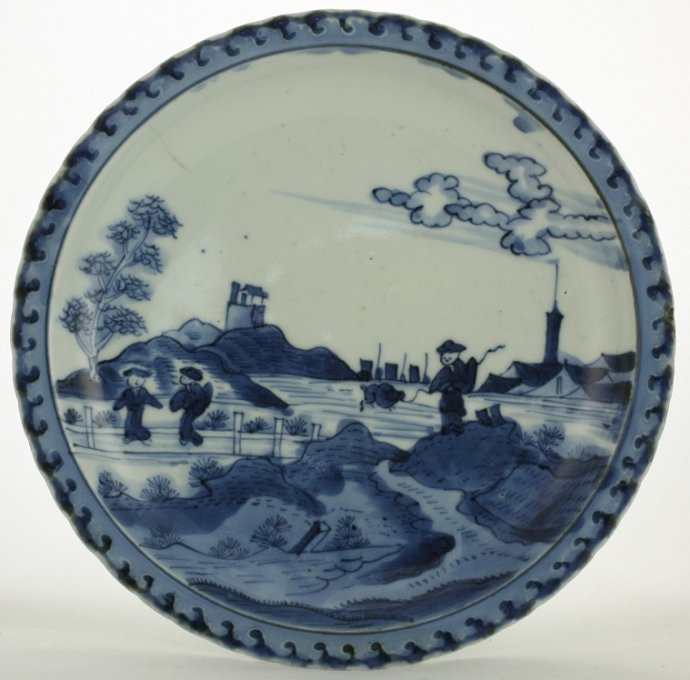
Sold Ceramics - Sold Japanese wares with Western Designs 1653-1800 - Page 1
Object 2010749
Dish
Japan
c.1700
Height 27 mm (1.06 inch), diameter of rim 195 mm (7.68 inch), diameter of footring 120 mm (4.72 inch)
Dish on footring, flat rim with a moulded, wavy, edge in relief. On the base four spur-marks in a Y-pattern. Decorated in underglaze blue with a village with a church and houses, a lighthouse with trees, figures with a cow, and the poles with clouds. The slightly crimped rim is painted with a wave-scroll border. On the reverse three sprays of flowering branches. The low footring is encircled with a double concentric band.
This design on this dish has traditionally been called 'Deshima' or 'Scheveningen'. It certainly does not depict the Dutch factory in Deshima (Nagasaki), a fan-shaped, man-made island in Japan to which Westerners were restricted between 1641 and 1862. Scheveningen, a fishermen´s village on the Dutch coast near The Hague, is a more appropriate name. In fact 47 "Scheveningen" plates were already mentioned in the 1778 sale catalogue of the porcelain shop of Martha Raap in Amsterdam, clearly indicating this type. Research was undertaken to find the print that was used as a model, non with this view have come to light. it is therefore possible that another source was used, maybe a plate or dish in the so-called Frijtom style. This is the most common version of this design, later copied by the Chinese. The design, almost certainly copied from a drawing by Frederick van Frijtom (1652-1702), was highly popular in The Netherlands, and possibly also in Japan as a kind of Western exoticism. The rim design is unique in Chinese export porcelain and is almost certainly after a silver original. (Howard & Ayers 1978, vol. 1, pp.72-73), (Terwee 1989, pp.494-501), (Jörg 2003/1, p.240)
These dishes with the so called 'Deshima' or 'Scheveningen' design first appeared, in underglaze blue, on Japanese dishes of around c.1700. In the collection of the Groninger Museum is a blanc Chinese porcelain dish overdecorated in Delft (the Netherlands) c.1700-1730 with identical design. This dish is an original Japanese version. (Jörg 2003/1, cat. 307a)
For identically shaped and decorated dishes, please see:
- Japanese Porcelain, (S. Jenyns, Faber & Faber, London / Boston, 1979), cat. 19a, (ii).
- Porcelain for Palaces. The Fashion for Japan in Europe 1650-1750, (J. Ayers, O. Impey & J.V.G. Mallet, Oriental Ceramic Society & The British Museum, London 1990), p.276, cat. 324.
- Ko-Imari from the collection of Oliver Impey, (Barry Davies Oriental Art, London, 1997), p. 113, cat. 67.
- The Voyage of Old-Imari Porcelains: Exhibition Catalogue of the Kyushu Ceramic Museum, Arita 2000, cat. 72.
- Complete Catalogue of the Shibata Collection, (The Kyushu Ceramic Museum, Kyushu 2003), p.326, cat. 2549.
- Faszination des Fremden: China - Japan - Europa, (D. Antonin & D. Suebsman, Hetjens-Museum, Deutsches Keramikmuseum Düsseldorf, 2009), pp.242-243, cat. 98.
For a similarly, sold, Chinese version, please see:
Condition: Three hairlines to the rim.
References:
Lunsingh Scheurleer 1971, cat. 65
Ayers, Impey & Mallet 1990, cat. 324
Antonin & Suebsman 2009, cat. 98
Price: Sold.
More pictures of object 2012173, another identically, shaped, sized and decorated, sold dish >>
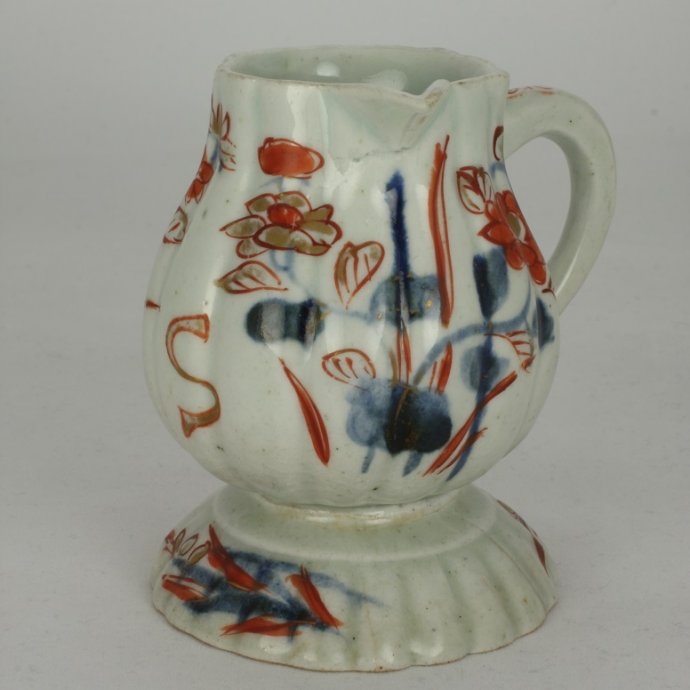
Sold Ceramics - Sold Japanese wares with Western Designs 1653-1800 - Page 1
Object 2010146
Ewer
Japan
1700-1720
Height 100 mm (3.94 inch), diameter of belly 75 mm (2.95 inch), diameter of mouthrim 35 mm (1.38 inch)
diameter of footring 50 mm (1.97 inch)
Ewer of ribbed pear form on a domed unglazed base. A side loop handle and a triangular spout. Imari decorated in underglaze blue, iron-red and gold with around the foot flower sprays. On the body two groups of flowering plants flanking an initialled 'S' for the Dutch word soya / zoja or soy. On the handle a floret between scrolls.
A specific group of ewers is decorated with the letters 'O', 'A', or 'S' indicating their contents: 'O' stands for olie (oil), 'A' for azijn (vinegar), 'L' for limoen (lemon), the 'S' or 'Z' for soya or zoja (soy). They were used at the dinner table in The Netherlands. Arts adds the letter 'C' for conserven (?) (preserves). This ewer was made following a European glass or silver original and was, most likely, part of a cruet comprising set.(Jörg 2003/1, p.176), (Arts 1983, p.50)
For an identically shaped, sized and decorated ewer initialed with the Dutch letter 'A' for azijn (vinegar), please see;
Condition: A firing crack to the bottom and a T-shaped crack to the foot caused during the firing process.
References:
Price: Sold.

Sold Ceramics - Sold Japanese wares with Western Designs 1653-1800 - Page 1
Object 2012087
Ewer
Japan
1700-1720
Height 93 mm (3.66 inch), diameter of belly 62 mm (2.44 inch), diameter of mouthrim 32 mm (1.26 inch), diameter of footring 52 mm (2.05 inch), weight 140 grams (4.94 ounce (oz.))
Ewer of ribbed pear form on a domed base. A side loop handle and a triangular spout. Imari, decorated in underglaze blue, iron-red and gold with around the foot flower sprays. On the body two groups of flowering plants flanking a reserved roundel with the initial 'Z' for the Dutch word zoja (soy). On the handle a floret between scrolls.
A specific group of ewers is decorated with the letters 'O', 'A', or 'S' indicating their contents: 'O' stands for olie (oil), 'A' for azijn (vinegar), 'L' for limoen (lemon), the 'S' or 'Z' for soya or zoja (soy). They were used at the dinner table in The Netherlands. Arts adds the letter 'C' for conserven (?) (preserves). This ewer was made following a European glass or silver original and was, most likely, part of a cruet comprising set. (Arts 1983, p.50), (Jörg 2003/1, p.176)
For an identically shaped, sized and decoarted ewer with the Dutch initial 'S' for soja (soy), please see:
Condition: Some spots to the rim caused by popped bubbles of glaze during the firing process, a firing tension crack to the inner foot and a tiny fleabite to the tip of the spout.
References:
Price: Sold.

Sold Ceramics - Sold Japanese wares with Western Designs 1653-1800 - Page 1
Object 2010196
Ewer
Japan
1700-1720
Height 100 mm (3.93 inch), diameter 75 mm (2.95 inch), diameter of mouthrim 31 mm (1.22 inch), diameter of footring 50 mm (1.96 inch), weight 157 grams (5.54 ounce (oz.))
Oviform ewer on footring, wide neck with pinched spout. Curved pierced handle placed at an angle to the spout. Imari decorated in underglaze blue, iron-red and gold with flowering prunus branches and a reserved roundel with the initial 'O' for the Dutch word olie (oil), the underglaze blue handle and spout set at right angles.
A specific group of ewers is decorated with the letters 'O', 'A', or 'S' indicating their contents: 'O' stands for olie (oil), 'A' for azijn (vinegar), 'L' for limoen (lemon), the 'S' or 'Z' for soya or zoja (soy). They were used at the dinner table in The Netherlands. Arts adds the letter 'C' for conserven (?) (preserves). (Arts 1983, p.50), (Jörg 2003/1, p.176)
For an identically decorated ewer, please see:
For an identically decorated ewer, decorated with the initial 'A', please see:
-
Japanese wares with Western Shapes or Designs 1653-1800 - Page 1 - Object 2010227.
- China for the West. Chinese Porcelain and other Decorative Arts for Export illustrated from the Mottahedeh Collection, (D.S. Howard & J. Ayers, Philip Wilson Publishers for Sotheby Parke Bernet Publications, London 1978), vol. 1, p.132, cat. 111.
For an identically decorated ewer, decorated with the letter 'Z', please see:
-
Japanese wares with Western Shapes or Designs 1653-1800 - Page 1 - Object 2010707.
- Japanese porcelain. A collector's guide to general aspects and decorative motifs, (P.L.W. Arts, De Tijdstroom, Lochem, 1983), p.50, Plate 22.
- Ceramics crossed overseas. Jingdezhen, Imari and Delft from the Collection of the Groninger Museum, (C.J.A. Jörg et al., Tokyo, 1999), p.74, cat. 97-2.
Condition: A firing flaw to the body.
References:
Price: Sold.

Sold Ceramics - Sold Japanese wares with Western Designs 1653-1800 - Page 1
Object 2012065
Dish
Japan
Early 18th Century
Height 59 mm (2.32 inch), diameter of mouthrim 341 mm (13.43 inch), diameter of footring 173 mm (6.81 inch), weight 1,462 grams (51.17 ounce (oz.))
Dish on footring, spreading flat rim. On the base five spur-marks in an X-pattern. Imari, decorated in underglaze blue, iron-red, green and gold. In the centre a richly filled flower vase on a shelf with an overhanging cloth, the flowers partly in underglaze blue. On each side a bird looking upwards. The sides with a dark blue ground with a diaper pattern in gold and eight reserved panels alternately filled with a flowerpot or a landscape with a tree and flowering plants. The rim with a lambrequin border with hanging tassels. Gilt edge. The reverse is undecorated.
Jörg states that the border design is the same as that on the armorial porcelains of the Van Buren and Bambeeck families consequently, this dish is dated accordingly. The central decoration was probably copied from a European print or model and it is therefore that part of the flowers have been painted in underglaze blue, which required close cooperation with the enamellers. It is interesting to note, however, that the enamelled flowers have fancy shapes while the tulip-like underglaze blue ones are more realistic. No other examples with this design seem to be recorded, but the Gen'emon Kiln Museum in Arita has a later, less refined imitation with a different border, dated 1730-50, indicating a continuing interest in this decoration. (Jörg 2003/1, p.238, cat.303)
For the only other recorded, identically shaped, sized and decorated, dish, please see:
For the Van Buren Armorial dish with indentically border design, please see:
- Oosters porselein. Delfts aardewerk. Wisselwerkingen, (C.J.A. Jörg, Groningen, 1983), pp.120-123, cat 85.
- Interaction in Ceramics. Oriental porcelain and Delftware. (C.J.A. Jörg, Hong Kong, 1984), pp.132-133, cat. 85.
- Porcelain for Palaces. The Fashion for Japan in Europe 1650-1750, (J. Ayers, O. Impey & J.V.G. Mallet, Oriental Ceramic Society & The British Museum, London 1990), p.220, cat. 231.
- Fine & Curious: Japanese Export Porcelain in Dutch Collections, (C.J.A. Jörg, Hotei Publishing, Amsterdam 2003), p.232, cat. 295.
For the Bambeeck Armorial dish with identically border design, please see:
Condition: Firing flaws to the rim and base and a re-stuck piece to the rim.
References:
Ayers, Impey & Mallet 1990, cat. 231
Jörg 2003/1, cat. 295, 297 & 303
Price: Sold.
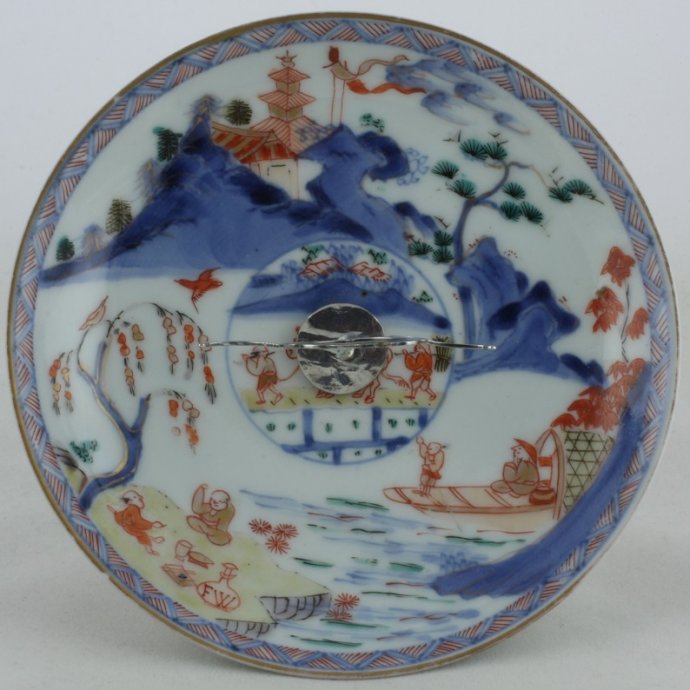
Sold Ceramics - Sold Japanese wares with Western Designs 1653-1800 - Page 1
Object 2012088
Saucer (converted into a tazza)
Japan
1700-1720
Height 85 mm (3.35 inch), diameter of rim 131 mm (5.16 inch), diameter of (silver) footring 70 mm (2.76 inch), weight 172 grams (6.07 ounce (oz.))
Saucer on footring, straight rim, fitted with engraved Dutch silver mounts (marked) converting it into a tazza. Imari, decorated in underglaze blue, iron-red, black, gold and various other translucent enamel colours. Two farmers walking with a leashed water buffalo near rocks and trees with birds in flight in a central roundel. On the sides a riverscape with mountains, houses, flags and pine trees. Two fishermen in a boat on a river. On a rocky river bank two figures are having a pick nick, besides them on the ground stands a teacup on a footring, a rectangular box with chop sticks and a clearly recognisable bottle with the initials 'FW'. Around the rim a zig-zag lines pattern border. On the reverse three flower sprays. The silver mounts are marked 'FP' most likely the initials of the (unknown) maker.
In 'Fine & Curious' an identically decorated saucer is published. On this saucer we see the same scene with the same two fisherman having a pick nick on a rocky river-bank with besides them on the ground a teacup on a footring, a rectangular box with chop sticks and a clearly recognisable bottle with the initials 'FW'. Jörg states that the initials 'FW' could very well indicate the owner or the contents, for example Franse Wijn (French wine). In this context it is interesting to note that parts of an export teaset are known that have an Imari decoration of a scene of two Japanese pick nicking on a rocky riverbank under a tree. The bottle with the initials 'FW' is clearly recognisable. European objects were greatly desired in Japan and such inscribed bottles, regarded as exotic Western objects, may not only have been made for Dutch clients, but also for the domestic market. It is tempting to imagine that they were used for sake instead of wine. (Jörg 2003/1, p.221, cat. 276a)
A saucer with a similar decoration is known in the Musée Ariana in Geneva. On Japanese porcelain it is already very rare to see an image of a identifiable type of export porcelain, but the image of such a specific object (the bottle with FW initials) is unique. The scene is traditional and does not refer to the Dutch, Decima or the Dutch East India Company (VOC). The two pick nicking figures are Japanese dressed, so it could be obvious that they drink sake (rice wine), so the bottle is in use as a sake bottle. It could very well be that this scene gives a representation of the habits in use in Japan at that time. Upper class people in Japan have always been interested in exotic ceramics and it can be read in VOC documents that Delfts Faience and German stone good were given as presents to high officials in Nagasaki and Edo. In that interest fits the use of a Western object like the bottle. Remains the question, are the initials a coincidence or were they ordered? Did the porcelain painter have a 'FW' bottle as an example which he copied as an exotic object or was there a tea service ordered by a Dutchman, for example for the person who also ordered the original 'FW' bottles? This seems not to be very likely because the commande element is so low prominent something not very likely to fit in that time. It is however so that bottles like this where used by Japanese and Europeans to contain alcoholic beverages. (Jörg 1989/1, pp. 396-407)
Two identically shaped, sized and decorated saucers are in the collection of Augustus the Strong in Dresden and registered under the number P.O. (Porzellan Ostasien) 5061 and 5061. For this dish, please see;
For an identically decorated teacup that was donated earlier to the collection of Oriental ceramics of the Groninger museum, please see:
Condition: A fleabite to the rim.
References:
Jörg 2003/1, p.221, cat. 276a.
SKD Online collection, PO. 5060
SKD Online collection, PO. 5061
Price: Sold.
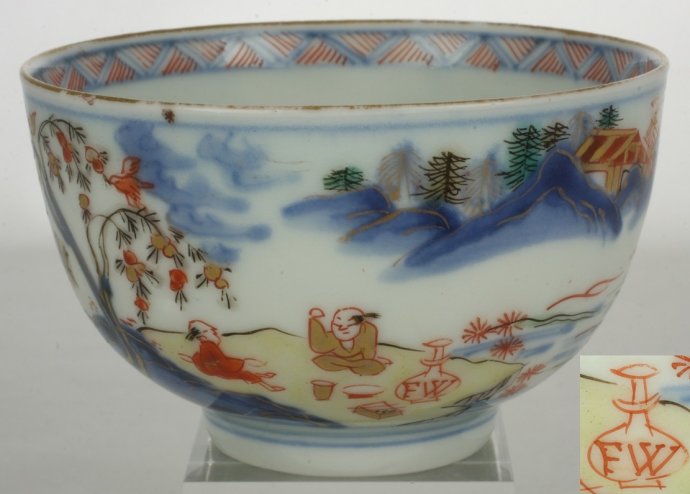
Sold Ceramics - Sold Japanese wares with Western Designs 1653-1800 - Page 1
Object 2010609
Teacup
Japan
1700-1720
Height 47 mm (1.85 inch), diameter of rim 77 mm (3.03 inch), diameter of footring 35 mm (1.38 inch), weight 59 grams (2.08 ounce (oz.))
Teacup on footring, straight rim. Imari, decorated in underglaze blue, iron-red, black, gold and various other translucent enamel colours. On the outside a riverscape with mountains, houses, flags and pine trees. Two fishermen in a boat on a river. Two farmers walking with a leashed water buffalo near rocks and trees with birds in flight. On a rocky river bank two figures are having a pick nick, besides them on the ground stands a teacup on a footring, a rectangular box with chop sticks and a clearly recognisable bottle with the initials 'FW'. On the bottom in a single circle flowering stems and around the rim a zig-zag lines pattern border.
In 'Fine & Curious' an identically decorated saucer is published. On this saucer we see the same scene with the same two fisherman having a pick nick on a rocky river-bank with besides them on the ground a teacup on a footring, a rectangular box with chop sticks and a clearly recognisable bottle with the initials 'FW'. Jörg states that the initials 'FW' could very well indicate the owner or the contents, for example Franse Wijn (French wine). In this context it is interesting to note that parts of an export teaset are known that have an Imari decoration of a scene of two Japanese pick nicking on a rocky riverbank under a tree. The bottle with the initials 'FW' is clearly recognisable. European objects were greatly desired in Japan and such inscribed bottles, regarded as exotic Western objects, may not only have been made for Dutch clients, but also for the domestic market. It is tempting to imagine that they were used for sake instead of wine. (Jörg 2003/1, p.221, cat. 276a)
A saucer with a similar decoration is known in the Musée Ariana in Geneva. On Japanese porcelain it is already very rare to see an image of a identifiable type of export porcelain, but the image of such a specific object (the bottle with FW initials) is unique. The scene is traditional and does not refer to the Dutch, Decima or the Dutch East India Company (VOC). The two pick nicking figures are Japanese dressed, so it could be obvious that they drink sake (rice wine), so the bottle is in use as a sake bottle. It could very well be that this scene gives a representation of the habits in use in Japan at that time. Upper class people in Japan have always been interested in exotic ceramics and it can be read in VOC documents that Delfts Faience and German stone good were given as presents to high officials in Nagasaki and Edo. In that interest fits the use of a Western object like the bottle. Remains the question, are the initials a coincidence or were they ordered? Did the porcelain painter have a 'FW' bottle as an example which he copied as an exotic object or was there a tea service ordered by a Dutchman, for example for the person who also ordered the original 'FW' bottles? This seems not to be very likely because the commande element is so low prominent something not very likely to fit in that time. It is however so that bottles like this where used by Japanese and Europeans to contain alcoholic beverages. (Jörg 1989/1, pp. 396-407)
Condition: A short hairline to the rim.
References:
Jörg 2003/1, p.221, cat. 276a.
The Groninger Museum already had a identically decorated saucer in their collection of Oriental Ceramics but the matching teacup was missing. I thought this was a wonderful opportunity to once again complete this unique and very rare set so I decided to donate this teacup to the collection of Oriental ceramics of the Groninger Museum, Groningen, The Netherlands.

Sold Ceramics - Sold Japanese wares with Western Designs 1653-1800 - Page 1
Object 2012182
Dish
Japan
1730-1750
Height 30 mm (1.18 inch), diameter of rim 225 mm (8.85 inch), diameter of footring 124 mm (4.88 inch), weight 451 grams (15.91 ounce (oz.))
Dish on footring, flat rim. On the base four spur-marks in a Y-pattern. Decorated in underglaze blue with an unknown European coat of arms; on the shield three severed bearded heads facing forward against a vertical striped background. The shape of the shield consists of volutes, the mantling around it is made up of fem branches, flowers and a putto head, a crown on top. On the sides four cartouches filled with stripes on a diaper pattern ground, on the rim three flower heads surrounded by leafy scrolls ((karakusa (spiky lotus)). The reverse is undecorated.
Japanese porcelain decorated with the coat of arms of Batavia officials and wealthy burghers was elaborate and exclusive. These pieces are rare and date mainly to the late 17th and early 18th century. Although it must have been as easy to order this porcelain as the initialled bottles, it did not happen frequently. We can only assume that there was a preference for the cheaper and easy-to-order Chinese armorial wares, which stimulated the fashion that quickly developed in the 1690s. One of the earliest known examples are dishes with the Pancras-De Vicq arms made for the occasion of their marriage in 1667. Even earlier are a few 17th-century bottles of old-fashioned shape with the coat of arms of Van Outshoorn, Valckenier, and other wealthy and influential Dutch families, while the later teacups and saucers with the Huydecoper arms will have been part of a teaset. Apparently armorial Kakiemon was never made, but we have the small group in Imari with the arms of the Van Buren, Brederode and Bambeeck families so exhuberantly decorated in Marot style. The Van der Meij pieces are a late representative of this group. In all, it is a very small harvest compared to the Chinese output since 1700. (Jörg 2003/1, p.211)
This as yet still unidentified coat of arms is probably of a Dutch family considering the style of the shield, mantling and crown (courtesy of Angela Howard, UK).
The overall armorial style is transitional, somewhere between Louis XIV and Louis XV(rococo), c.1740-1750.
For an identically decorated dish, please see;
- The Inter-Influence of Ceramic Art in East and West (Idemitsu Museum of Arts, Tokyo 1984), p. 50, cat. 173.
- Four Centuries of Blue & White. The Frelinghuysen Collection of Chinese And Japanese Export Porcelain, (B. MacGuire, Ad Ilissum / Paul Holberton Publishing, Chicago, 2023), p.331, cat. 276.
Condition: Perfect.
References:
Price: Sold.

Sold Ceramics - Sold Japanese wares with Western Designs 1653-1800 - Page 1
Object 2010697
Bottle
Japan
Late 18th-early 19th century
Height 174 mm (6.85 inch), diameter 98 mm (3.86 inch), diameter of mouthrim 32 mm (1.26 inch), diameter of footring 60 mm (2.36 inch)
Bottle of slightly tapering cylindrical shape on low footring, the shoulder tapering into a short neck with a double mouthrim. Greyish body. Inscribed in a light underglaze blue with 'JAPANSCHZOYA' (Japanese soy).
The shape and lettering of this bottle show an individual touch and differ from the more later 19th-century pieces. It is therefore considered here as a forerunner and is dated accordingly. These bottles were used as containers for transporting soy and sake to the West. (Jörg 2003/1, p.224)
For similarly shaped and decorated bottles, please see:
- The Japanese porcelain trade of the Dutch East India Company after 1683, (T. Volker, Rijksmuseum voor Volkenkunde, E.J. Brill, Leiden 1959), Pl. XVII, cat. 22.
- Fine & Curious. Japanese Export Porcelain in Dutch Collections, (C.J.A. Jörg, Hotei Publishing, Amsterdam, 2003), p.224, cat. 282.
Condition : A hairline to the neck and fine crazing to the glaze.
References:
Volker 1959, Pl. XVII, cat. 22.
Price: Sold.



.jpg)
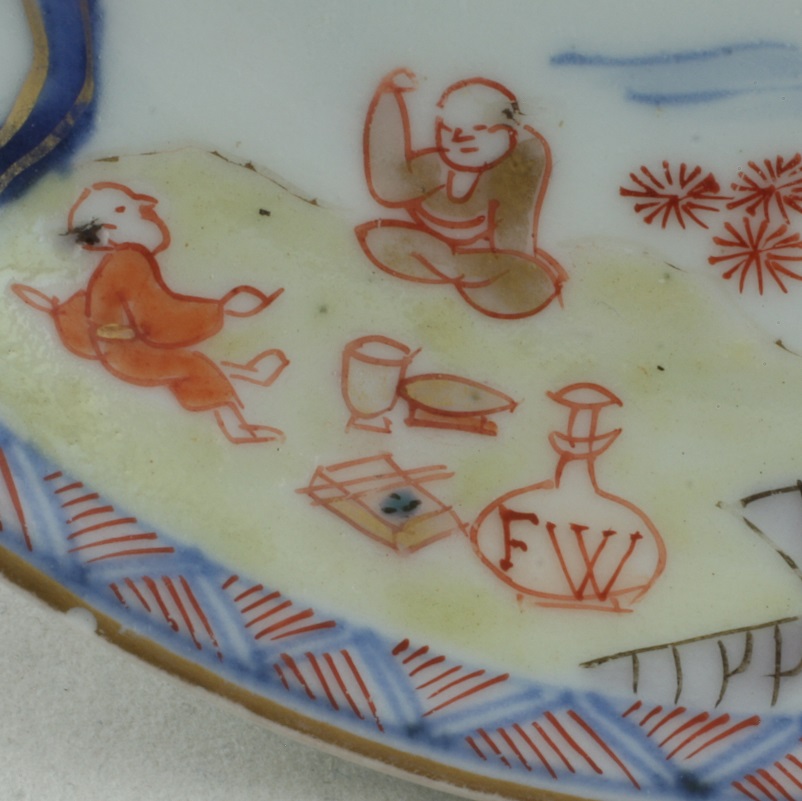

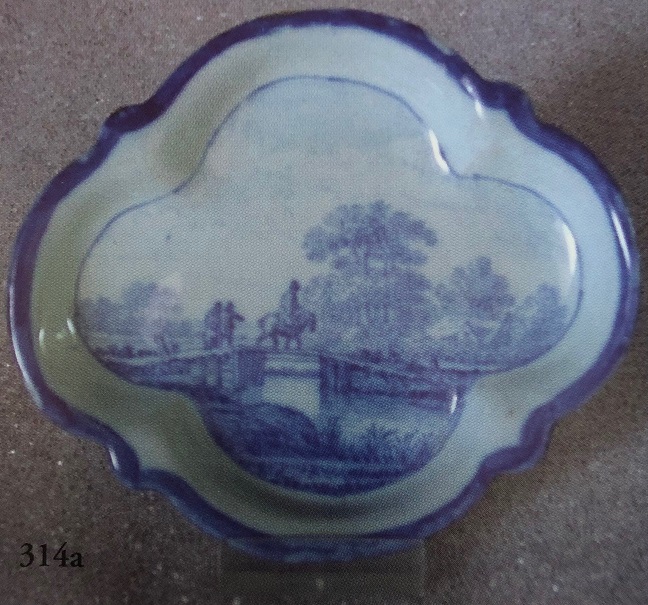

 create websites
create websites